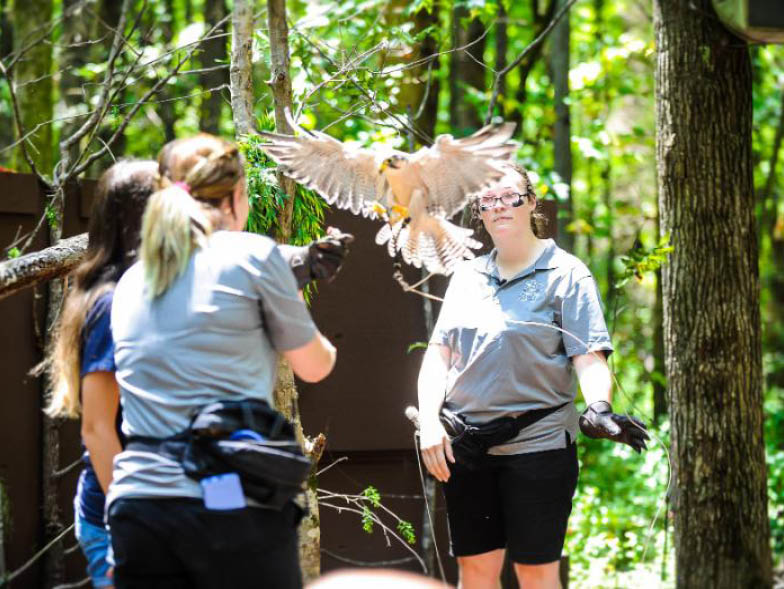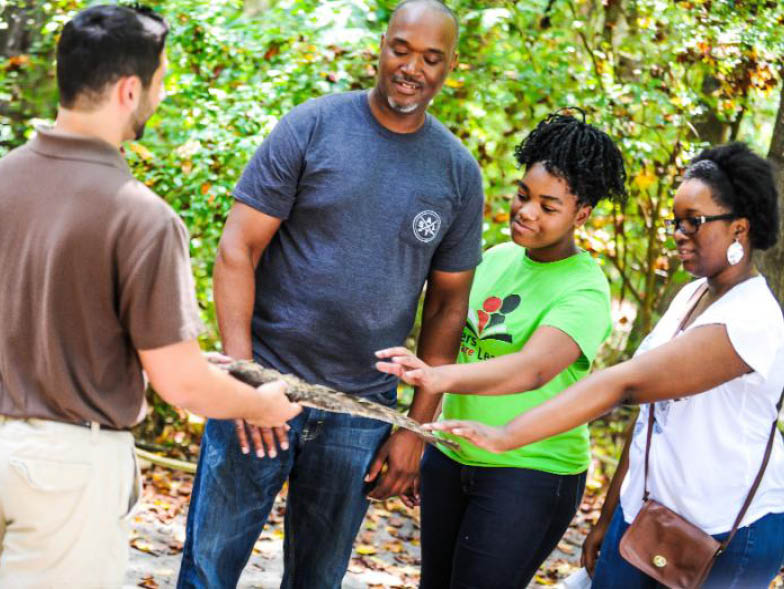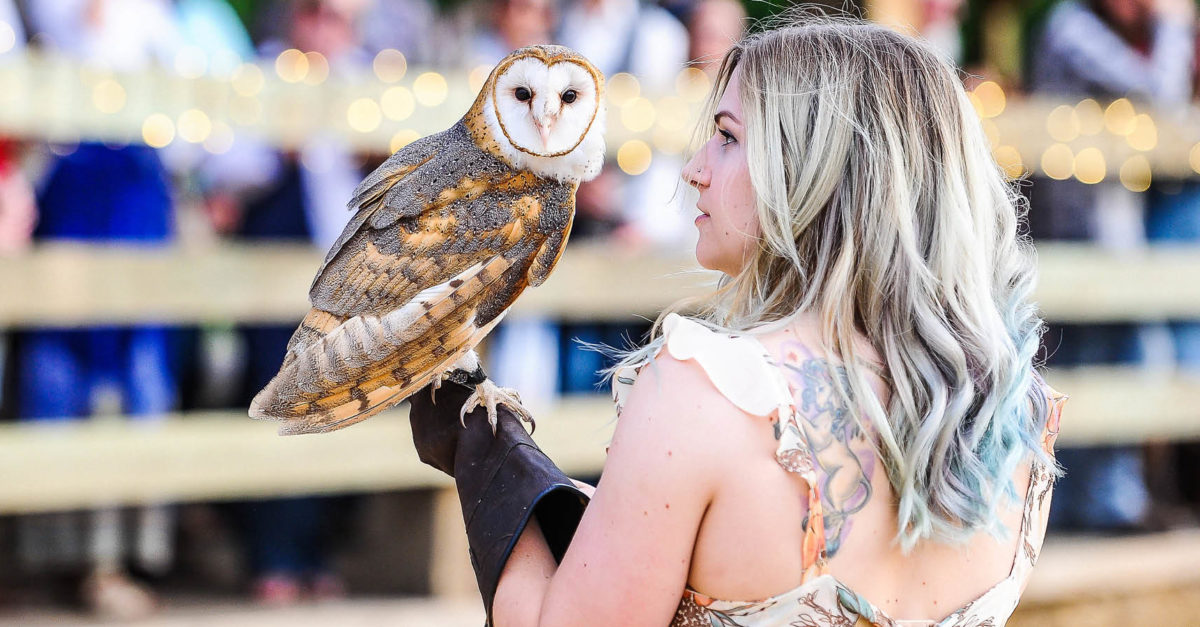The Rapture of Raptors
While walking the halls of a University of North Carolina at Charlotte campus building late one evening in 1984, an administrator encountered an unusual visitor in one of the elevators. His copassenger wouldn’t have been able to push the buttons (since it didn’t even have opposable thumbs).
The mysterious rider?
A vulture that had escaped from the Carolina Raptor Recovery and Rehabilitation Center, which was founded nearly ten years prior. By the time this peculiar elevator ride occurred, the center was already beginning to outgrow its small corner of the basement in the UNCC biology building.

Since 1975, ornithology professor Dick Brown, with the aid of student Deb Sue Griffin, had been caring for injured raptors. The first raptor, dubbed Patient 1, was a broad-winged hawk brought in to Brown after it was discovered, injured, in the area around campus. When word spread of the makeshift treatment facility, people started bringing in more birds for care.
From One to Five-Hundred
By the early eighties, the Carolina Raptor Recovery and Rehabilitation Center (now just Carolina Raptor Center) was taking in roughly eighty injured raptors per year—helping to nurse them back to health and studying their behaviors as well as environmental factors that may have led to their injuries. The call for expansion was answered in 1984, when the center moved to its current grounds at the Latta Plantation Nature Preserve, just twenty-five minutes outside of Charlotte.
CRC has come a long way from its early days at the nature preserve, where obstacles like no water or electricity made it difficult to operate on an as-normal basis. But by 1984, the center welcomed its five-hundredth patient, and the goal for a visitor center and more permanent treatment facilities was realized.
The overarching mission of CRC—to rescue and rehabilitate raptors—has remained constant, but associate executive director Michele Miller Houck says that, in the more than forty years since its inception, there has been enormous progress made in education as well. “Our stated mission was the conservation of raptors, but we are really evolving to instill wonder in the natural world and engaging visitors in our mission,” she says. Education is now a large part of what CRC does—with numerous exhibits and programs dedicated to not only inspiring curiosity about these birds but also reducing the number of raptor injuries in the wild caused by humans.

An Encounter With a Raptor
Similar to a zoo, CRC has multiple walking trails with both enclosed and walk-through exhibits that delve into the environment of some of the resident raptors. With more than thirty species of raptors at the center, visitors can get an up-close view of nesting bald eagles, learn about the behavior of corvids (one of the smartest species of birds), and step through a forest of owls.
In addition to daily exhibits, CRC offers special weekend programs that put visitors in the center of the action. One of the most exciting programs, held during the summer months, is Raptor Encounters, which, according to Miller Houck, is among the most popular. Visitors can walk side by side with caretakers as they deliver food to the raptors, get a behind-the-scenes look at some of the flight shows, and uncover the mysteries of the often misunderstood vulture.
To see just how smart these animals are, however, guests need to come back in the fall, winter, or spring, when CRC hosts a program on vulture feedings.
“Vulture feedings are really cool,” Miller Houck says. “Vultures are some of the smartest animals there are, so they need enrichment activities on a daily basis. In the feeding program, we highlight some of these activities like placing their food into pumpkins during Halloween.” CRC insists that the term “birdbrain” is simply a myth, and that most raptor species, including vultures, actually possess an intelligence level comparable to a toddler—a surprising fact for most visitors.

Education for children is also of the utmost importance, and both informal and formal classes are offered all year round to encourage future generations to care about raptor conservation and protection. Through its For a Day experiences, CRC puts kids in the shoes of a center employee—be it a keeper, veterinarian, or photographer—learning the ins and outs of the job.
Fascination and Preservation
Though humans have undoubtedly held a fascination with birds for thousands of years, misunderstanding them has also caused huge issues for raptor species, especially in North America, where practices like environmental destruction, hunting, and overfishing are detrimental to avian populations.
The medical facilities at CRC admit between eight hundred and one thousand birds of prey each year, making it one of the largest facilities of its kind in the world. Among the most common injuries are being hit by a car, gunshot wounds, and other injuries related to human habitation. “We see a fair number of injuries stemming from birds being caught in fishing lines and barbed wire, as well as running into things like soccer nets,” Miller Houck says. “Something we like to tell people is that we all grew up thinking that if something is biodegradable we can just toss it out the window, but that brings rodents and other small animals to the sides of the road and, in turn, raptors.”

Though 70 percent of raptors brought to the center survive through the first twenty-four hours after injury, the nearly twenty thousand birds that have come through CRC over the years are proof of the severity of the danger raptors are in. “All of these things that we do to connect people to the birds are learning opportunities to promote action and make people more aware of their behaviors,” she encourages.
Forging a connection between human fascination with birds and the ability to care for them is what CRC is all about, and that starts with an emphasis on making the visitor experience memorable. “We talk a lot about this at CRC, but I am really interested in creating a couple different kinds of wonder in our guests—one of which is that ‘wow’ factor people really get when we fly the birds,” Miller Houck says.
Part of this process will be adding on to the visitor experience with a brand new facility. Over the next year, CRC will join forces with the Mecklenburg County Park and Recreation Center and Quest Adventure Center to open a 13,000-square-foot nature conservancy. This new location will include a new-and-improved raptor trail, along with many new exhibits.
Miller Houck reveals the creative platform for the new facility: the ways in which birds have inspired humans for thousands of years—in art, science religion, culture, and so on. With a renewed sense of purpose in caring for these species, CRC hopes to meet people on a level of understanding and find common ground in the captivation of flight—a fascination that can help protect these birds for generations to come.
For more info, visit carolinaraptorcenter.org.






















